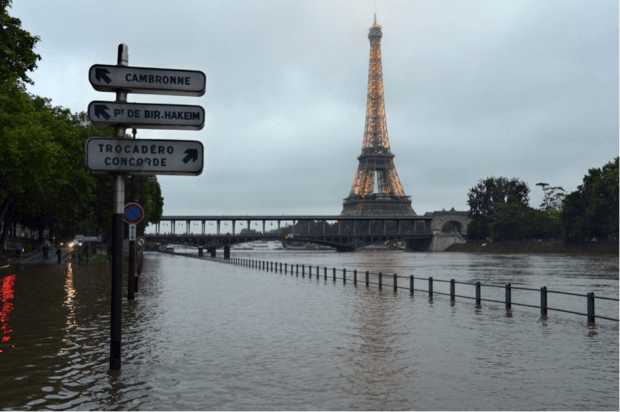Flood events are not restricted by geopolitical borders. In a landmass with multiple adjacent countries such as Europe, flood risk can have a wide-reaching impact on both business and society—directly because of property damage losses and indirectly because of supply-chain disruption and contingent business interruption.
Executive Summary
The sizable and growing economic impact of floods in Europe presents a significant opportunity to improve resilience in the region, both physically and financially. New modeling capabilities are helping insurers and reinsurers increase understanding of the characteristics that make flood hazard such a challenging risk to evaluate.Recent major floods in Europe have shown the potential for such large-scale flood losses, which our firm’s analysis found could be even larger in the future. Changes in both flood hazard and growth in the exposure at risk will be the main drivers of the increased losses. Data produced by RMS shows that nearly 10 percent of insurable exposure across Europe could be at risk of a 1-in-100-year inland flood. Or, put another way, exposure worth trillions of euros is at risk within high-hazard flood zones.
There are, however, flood mitigation strategies in place to protect a significant proportion of this exposure. Having an up-to-date view of flood mitigation schemes is critically important when evaluating flood risk. In particular, knowing the location and effectiveness of flood defenses helps support a more accurate evaluation.
By analyzing the exposure at risk using our current flood defenses data, we have shown that hundreds of billions of euros of insurable exposure is protected up to the 1-in-100-year standard of protection. This represents a large volume of potentially profitable flood business for the industry.
Flood Risk Is Not Static
Population growth, changing land-use patterns and a shifting climate are all factors affecting the frequency and intensity of flood events in Europe. Weather phenomena such as static low pressure systems, winter storm clusters and atmospheric rivers could become more frequent in the future as a result of climate change. Meanwhile, continued development both on and off flood plains acts to increase the likelihood of flash flooding and leads to an ever-growing volume of exposure at risk.
The floods that impacted France, Germany, Austria, Switzerland and Belgium in early June are a good example. Widespread flooding caused by storm Elvira swept across Northern Europe, affecting many major metropolitan areas, including Paris. At the time of writing, damage and business interruption claims was estimated to exceed €2 billion.
Such large-scale events that drive significant economic loss have highlighted the size of the “protection gap” for Europe flood. A clear example of this was the 2013 Central European floods, which caused economic losses of $16.8 billion (2013 currency rates), making it the costliest Europe flood event on record, yet only $4.2 billion of the losses were insured.
By understanding the characteristics that make flood hazard such a challenging risk to evaluate, the insurance industry can address the flood protection gap and improve the financial resilience of countries such as Germany—a country that has a high insurance penetration overall but where flood is underinsured.
What can insurers and reinsurers do to deepen their understanding of the risk?
Until recently, the complexity of the peril and the inability to model it sufficiently had limited the industry’s capacity to write and manage flood business. New technology has helped changed the status quo by enabling higher-definition modeling of this granular peril, helping to deepen our understanding of the underlying risk drivers to assist insurers to manage the risk more effectively.
However, insurers and reinsurers should be aware that unlike other perils, simply looking at the historical record to inform flood risk modeling is not enough. It does not capture the evolving nature of flooding. To write flood business with confidence and target a profitable portfolio, there are four key components of the risk that must be considered in the data, maps or models used to select and price the risk:
• Precipitation is the primary source of severe flooding, however, it comes in many different forms.
In the U.K., intense precipitation may arise from atmospheric rivers, narrow bands of concentrated moisture in the atmosphere.For Central Europe, many extreme precipitation events have arisen from moisture-laden, Mediterranean-originating, low-pressure systems that become “stalled” over the continent.
• Antecedent conditions can significantly exacerbate the risk. Two rainfall events with similar intensity-duration characteristics can lead to two completely different outcomes depending on the level of soil saturation. If heavy rainfall follows a particularly wet period or snowmelt and the ground is already saturated, the potential for flooding is much greater.
• Inland flood risk is dynamic; it develops spatially and over time. Spatial correlation of flood can also result in multiple adjacent countries experiencing damage and disruption from a single event. According to RMS estimates, approximately 80 percent of 1-in-200-year losses originate from pan-European flood events, representing the biggest driver of large losses to the industry. Such events can have a sizable footprint, impacting several countries, with typical inundation periods of at least three weeks.
Among the key takeaways:
- U.S. inland flood hazard is dynamic, something that is not fully reflected in the historical record. It can vary in time and space, lasting from hours to weeks and impacting single cities or entire river basins across multiple states.
- Antecedent conditions can have dramatic impact on the U.S. inland flood peril. Two precipitation events with similar intensity and duration characteristics can yield two completely different outcomes depending on how saturated the soils are before the onset of the event.
- Geographic and manmade changes constantly shape and reshape the U.S. inland flood landscape.
But flooding is also a very granular peril. Two locations just a few meters apart can be subject to two very different levels of risk. Therefore, it is important to understand both the local effects of flood hazard as well as its potential large-scale impact.
• The interaction between flood hazard and exposure at risk is always evolving.Assets at risk in flood-prone regions are always increasing, particularly in metropolitan areas. For example, the 1910 Greater Paris Flood caused losses amounting to $1-$2 billion in today’s money. Yet if the same flooding occurred today, where more expensive city developments have been built, the increased exposure at risk means losses could reach $30 billion.
High-value industrial exposure is often located close to rivers because of the need to use water for production or transportation; residential assets are also commonly located close to water because riverside property is deemed more attractive. All this places high-value exposure in the regions that are most at risk to flooding.
Compounding this problem is the fact that built-up environments are also naturally more prone to pluvial (surface water) flooding, as paved surfaces limit water infiltration, reducing capacity for excess water and channeling water more rapidly into temporary streams and rivers.
Similar to other natural perils, it is possible to reduce a property’s vulnerability to flood. Flood defenses can remove or at least mitigate the hazard; there are already high standard defenses currently protecting billions of euros of exposure. Other techniques to reduce vulnerability include more flood-resilient building design, construction and retrofitting applied to properties that previously have been inundated.
A detailed modeling approach is the key to a better understanding of the complexities of European floods. Gaining insights into the four key components of flood risk will empower insurers and policymakers to more accurately assess this dynamic risk at a granular resolution, supporting more informed decisions around flood risk transfer and mitigation strategies.





















![FL_EU_SituationMap_15June2016_v5[2]](/assets/FL_EU_SituationMap_15June2016_v52-620x437.jpg)
 Uncertainty Keeps Prices Up; No Prior-Year Loss Development: Travelers
Uncertainty Keeps Prices Up; No Prior-Year Loss Development: Travelers  Travelers: Distracted Driving Incidents Continue to Rise
Travelers: Distracted Driving Incidents Continue to Rise  AM Best Downgrades State Farm General Ratings
AM Best Downgrades State Farm General Ratings  USAA to Lay Off 220 Employees
USAA to Lay Off 220 Employees 










